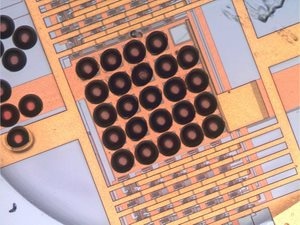Jun 13 2019
Microlenses are used by an increasing number of applications, including smartphone cameras, because these products help in improving their performance.
 Laser catapulting can also be used to fabricate an array of microlenses directly on top of a photodetector array. This is useful for directing more light onto the most sensitive parts of the detector. (Image credit: Martí Duocastella, Istituto Italiano di Tecnologia)
Laser catapulting can also be used to fabricate an array of microlenses directly on top of a photodetector array. This is useful for directing more light onto the most sensitive parts of the detector. (Image credit: Martí Duocastella, Istituto Italiano di Tecnologia)
Laser catapulting, a recently developed technology, could now make it less expensive and relatively easier to develop these small lenses with custom-made characteristics, for example, as focusing power or shape.
Scientists from Italy-based Istituto Italiano di Tecnologia reported their study results in The Optical Society (OSA) journal Optical Materials Express, describing how their latest laser-additive approach can be used for producing microlenses with the help of one laser pulse. The new technology also makes it possible to fabricate microlenses and microlens arrays directly on solar cells or cameras.
The performance of solar cells and cameras are improved by microlenses, which focus light into the most susceptible areas of the devices. For instance, microlenses are extensively utilized in the latest smartphone cameras to their boost imaging speed and sensitivity in low-light conditions.
Our fabrication approach simplifies the production of lenses while allowing more variety in the design and more flexibility in the environments where microlenses can be used. In addition to completely new applications, this method could lead to new cameras that acquire video under low light conditions, solar cells with improved efficiency and microscopes that are better at capturing fast processes.
Martí Duocastella, Research Team Leader¸ Department of Nanophysics, Istituto Italiano di Tecnologia
Catapulting with light
Despite their commercial availability, micro-optics can be extremely costly and difficult to integrate into current devices. Even in the case of conventional microlens fabrication techniques like photolithography, lenses cannot be integrated easily, or it is difficult to fabricate very densely packed microlens arrays.
To overcome these limitations, the researchers came up with laser catapulting. In this technique, a laser pulse is used for removing and catapulting a microdisk from a thin polymeric film and dropping it onto a distinct region of interest. The microdisk contains the polymer, which is subsequently heated so that it can reflow thermally, enabling capillary forces to mold the microdisk into a spherical lens. These capillary forces are the same forces that render water droplets spherical. Altering the laser beam shape makes it possible to fabricate microlenses with varied focusing characteristics or shapes, like circular, triangular, or rectangular.
Laser catapulting connects the dots between existing laser-based fabrication methods to solve problems with current microlens fabrication strategies. It fills the gap between the growing number of applications that require microlenses and the technologies capable of generating on-demand customized micro-optics.
Martí Duocastella, Research Team Leader¸ Department of Nanophysics, Istituto Italiano di Tecnologia
Once the researchers examined the association between the laser beam shape and the ensuing microdisks, they inspected the accuracy, precision, and reproducibility of their method. The team’s analysis revealed that the technique can perhaps be utilized to reproducibly create microlenses that have very high smoothness and radiuses ranging from 50 and 250 µm.
Determining the light collection capabilities of microlens arrays and the optical characteristics of the microlenses fabricated with the new method demonstrated that these micro-optics displayed diffraction-limited performance, which implies that these devices were as good as theory allows. According to the scientists, laser catapulting may be integrated with rapid laser beam shaping techniques for on-the-fly control of shape and optical performance of separate microlenses inside a microlens array.
Capturing fast biological processes
The team is planning to apply the laser catapulting method to develop microlenses on top of photodetector arrays as this would allow them to create a high-speed 3D microscopy system to define extremely fast biological processes, like virus trafficking or neuronal communications. The microlenses will boost the photodetectors’ light-collecting efficiency and thus reduce the imaging time.
These novel photodetector arrays offer important advantages compared to confocal microscopy but can’t collect as much light as traditional single point detectors. We believe that microlenses, and laser catapulting in particular, will help improve the performance of these photodetector arrays and expand their use among the microscopy community.
Martí Duocastella, Research Team Leader¸ Department of Nanophysics, Istituto Italiano di Tecnologia